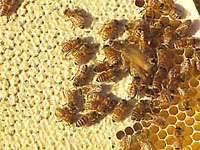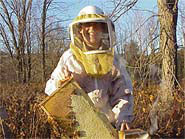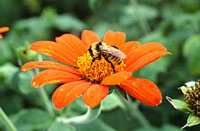by Ellen Ogden

Ellen Ogden is just giddy over the prospect of raising bees in her backyard this year.
In spring, Vermonters have maple syrup on their minds. But this time of year the quiet hum from beehives indicates another natural sweetener is on its way. As soon as the weather is warm enough for flowers to make pollen, honeybees are out of the hive and ready for action. Raw, unfiltered honey is a natural byproduct of pollination and retains the beneficial traces of pollen, propolis, and beeswax.
Yet, many beekeepers are not just in it for the honey. About one-third of our diet comes from insect-pollinated plants, and the honeybee is responsible for 80 percent of that pollination. Without bees, fruit trees would bear much less fruit, berries would shrivel on the vine, and gardeners would not have all that zucchini to give away. Every year, millions of bees are lost to environmental hazards, diseases, and parasitic mites that attach themselves to the bees and spread throughout the hive. Also, last year saw an unprecedented loss of bee colonies. In some areas up to 80 percent of the hives were abandoned due to what's been dubbed Colony Collapse Disorder, the cause of which still isn't known.
These are reasons enough for me to switch from a "wannabee" to a "newbee" beekeeper this spring. Along with my garden catalogs, I've started reading the Betterbee catalog, from Greenwich, New York, with a serious eye to ordering a starter colony. I live in a semi-rural setting, with a tiny backyard. However, bees will travel up to three miles to collect nectar, with each bee visiting as many as 300 flowers every day. Besides increasing my vegetable production, I hope they will pollinate my neighbor's gardens as well, and in the process build a healthy landscape and make some honey!

Honeybees not only produce honey, they are also essential for pollinating a wide range of our favorite fruits and vegetables.
I am learning there are several types of bees readily available to beekeepers. Selecting the right type involves balancing honey production, mite resistance, and personality. The most popular types of bees are Russian and Italian. Getting to know the different personalities is a good place to start. For advice, I consulted my friend Maddie, an organic gardener and long time beekeeper.
"Russians are good honey producers and less susceptible to mites, yet are prone to swarming," she explains. Sometimes the bees in a hive will decide it's time to raise a second queen; then, one queen and half the bees will leave the hive (swarm) and the other half will remain behind with the other queen. Often, swarming is a result of overcrowding, but there may be other factors, too.

Bees are naturally docile, but it makes sense to have bee protection while working with hives.
"One afternoon," Maddie continues, "while I was in my garden, I began to hear a loud buzzing noise that increased to a roar. Then suddenly a swarm of thousands of bees flew out of the hive and formed a dark cloud," she says, motioning upwards with her arms. The swarm clung to their queen like a magnet, perched on a branch of a nearby apple tree. Once a hive decides to swarm there's no way to reunite the departing bees with the remaining ones. So Maddie acted quickly and called a farmer friend who lives down the road and had a hive but hadn't ordered her bees yet. Leaning a ladder against the tree, Maddie sawed off the branch and captured the whole colony by coaxing it into a bee box. The bees happily resettled in the new hive at the farm and by the end of the summer the farmer reported her vegetable yield was improved by 100 percent. "It was thanks to all those bees," she smiled proudly.

Bees collect pollen from a wide variety of flowers. The type of flower will influence the flavor of the honey.
Figuring out where to place the hives is my next question. My small backyard works because the hives will be visible from my kitchen window, located beneath an old apple tree and next to the vegetable garden and tool shed. Yet my kids are fearful of the bees being close by. So, I've decided on Italian bees, since they are relatively good-natured, and I have my eye on a beehive with a copper roof, a decorative element that integrates nicely with my kitchen garden. Maddie is reassuring. "Bees are gentle," she explains, as we sip tea from her kitchen, the walls painted a honey color with bee paraphernalia dotting every surface of the counter. "They are like domestic pets, except they take care of themselves. All I do is provide them with a good home, and in return, they produce wonderful bee products," she says.
Since every type of flower begets its own type of honey, by extracting honey at different times of the year (when different flowers are in bloom) you can get different flavors. I can't wait until the end of the summer when I can savor my own locavore honey. I can practically taste the lemony notes from the lemon gem marigolds and bee balm, the hint of cinnamon from the scented basil flowers, and the peppery notes of nasturtium and scarlet runner bean flowers. Beekeeping has added a new dimension to my winter ritual of ordering seeds and designing my garden. Instead of focusing on the just the food I like to eat, now I'm thinking about bees.
Ellen Ecker Ogden is a garden writer and cookbook author based in Vermont. She periodically writes Food for Thought essays about gardening, food, and related subjects for the Edible Landscaping newsletter.
 Charlie Nardozzi is an award winning, nationally recognized garden writer, speaker, radio, and television personality. He has worked for more than 30 years bringing expert gardening information to home gardeners through radio, television, talks, tours, on-line, and the printed page. Charlie delights in making gardening information simple, easy, fun and accessible to everyone. He's the author of 6 books, has three radio shows in New England and a TV show. He leads Garden Tours around the world and consults with organizations and companies about gardening programs. See more about him at Gardening With Charlie.
Charlie Nardozzi is an award winning, nationally recognized garden writer, speaker, radio, and television personality. He has worked for more than 30 years bringing expert gardening information to home gardeners through radio, television, talks, tours, on-line, and the printed page. Charlie delights in making gardening information simple, easy, fun and accessible to everyone. He's the author of 6 books, has three radio shows in New England and a TV show. He leads Garden Tours around the world and consults with organizations and companies about gardening programs. See more about him at Gardening With Charlie.
 Victory Seed Company has all the seeds you want for your best garden in 2024.
Victory Seed Company has all the seeds you want for your best garden in 2024.
For 25 years, the family-owned Victory Seed Company has provided the highest quality vegetable, herb and flower seeds to families across the country. We are passionate about providing you the best seeds available that give excellent germination, robust plants, and the harvest you want. With a catalog of over a thousand varieties, we have everything, and our prices are the kinds that we'd want to pay. We have hundreds of yesterday's heirloom vegetables, as well as today's award winning hybrid selections. Get to know us by visiting our website and browsing through our online vegetable seed catalog.